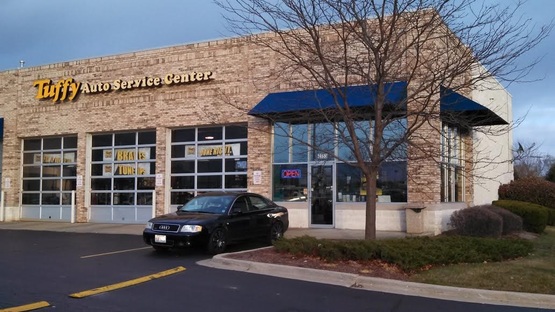What type of technology do you use? Do you prefer an 8-track tape or an iPod? When it comes to winter tires, much of Glendale Heights driver's perception dates back to when 8-track was the best way to listen to the Bee Gees.
Twenty years ago in Illinois, winter tires differed from highway tires only in their tread design. Illinois drivers called them snow tires back then, and they had big, knobby lugs that were designed to give good traction in deep snow. They had the same rubber compound as regular tires and they weren't very good on ice, packed snow or wet Illinois roads. They were not even very good on dry roads. They really helped in deep or loose snow, but they did a poor job the rest of the time. They were loud and rode hard. People couldn't wait to get them off in the spring.
Then all-season tires started to appear in Glendale Heights tire shops. All-season tires are really a compromise between summer and winter performance. They have acceptable hot weather ride and tread life and can get Illinois drivers through mild winter road conditions OK. But there are some really good reasons to consider winter tires.
Modern winter tires do a terrific job for Illinois driving in a wide range of winter conditions. First of all, below 45°F/7°C, regular tires become hard and inflexible. That means they don't provide the road grip Illinois vehicles need. Even if you don't live somewhere in Illinois with a lot of snow, but it still gets below 45°F/7°C in the winter, you will be safer with winter tires.
In addition, they are specifically designed to more effectively move snow and water. That's the key to traction on ice-packed snow and wet Glendale Heights area roads. They use a micropore compound that allows the tire to bite into ice and snow. They also use wider grooves that run around the circumference of the tread to expel snow from the tire better. The lugs and grooves on winter tires have a special shape that throws the packed snow out of the tread as the tire turns. The tread is then open when it comes back in contact with the road and can provide good traction for Illinois drivers.
Winter tires also have a lot of sipes. Sipes are thin slits in the tread. The edge of the sipes grab ice and packed snow to provide tons of traction and to expel water and slush out of the tread. Winter tires have a rounder casing to cut into the snow's surface. The treads on regular summer tires can actually get packed with snow instead and become very slick. Winter tires offer 25% to 50% more traction for Illinois drivers than all-season tires. And when it comes to stopping power, all-season tires take 42% longer to stop than winter tires. Sometimes that's the difference between getting home safely and spending the night in a snow bank.
Now back when the 8-track was king, Illinois drivers just put snow tires on the drive wheels. That worked out OK because the rubber compound was essentially the same. Now, winter tires provide so much more traction than all-season or summer tires, that there's a huge difference between the traction at the front and rear ends of the car if you only put winter tires on the drive wheels.
For example: if you take a corner on an icy road and the rear end starts to slide out, essentially the rear is trying to pass the front because it's going faster. If you have high traction winter tires only on the front, they are going to be much more effective at transferring cornering grip and stopping power to the front wheels. This will actually cause the rear end to whip out even more.
That's why tire manufactures instruct their dealers that they must install winter tires on the rear wheels as well whenever they put winter tires on the front end of any vehicle. It's a major safety concern. It's strongly recommended that winter tires be installed on all four wheels on rear wheel drive vehicles as well. The front tires do most of the steering and braking work - it only makes sense that you provide the front end with the best traction you can.
Glendale Heights drivers often assume that if they have four-wheel drive or all-wheel drive they don't need winter tires on all four wheels. Would you intentionally disconnect the four-wheel drive in poor road conditions? Of course you wouldn't, but that's essentially what you do if you only put winter tires on one end. It only makes sense to have the same level of traction and control at all four corners.
The province of Quebec in Canada has issued a law requiring all passenger vehicles, taxis and rental cars with Quebec license plates to install a full set of four winter tires between November 15th and April 1. It's that important.
Many modern cars have traction control and anti-lock brakes so Illinois drivers may think that they don't need winter tires. But you need traction to accelerate, steer and stop. The tires provide the traction so that the traction control and anti-lock brakes have something to work with.
Look for tires with the symbol of a mountain with a snowflake in it. This means the tire complies with the severe snow standard. All-season tires will have an M&S, for mud and snow, on the sidewall.
So when the Glendale Heights temperatures drop below 45°F/7°C, be sure you have a set of four winter tires for maximum performance on snow, packed snow, ice, plus wet and dry roads. Your friendly and knowledgeable Tuffy Tire & Auto Service Glendale Heights tire professional can help you find the right winter tire for your vehicle and driving needs.
Tuffy Tire & Auto Service Glendale Heights
1153 Bloomingdale Rd.
Glendale Heights, Illinois 60139
630-588-8846
 Win a FREE STANDARD OIL CHANGE
Learn more
Win a FREE STANDARD OIL CHANGE
Learn more
 Register your
Register your  Have a promo code?
Have a promo code? Sign up and start Saving.
Learn more
Sign up and start Saving.
Learn more
 Win a FREE STANDARD OIL CHANGE
Learn more
Win a FREE STANDARD OIL CHANGE
Learn more
 Register your
Register your  Have a promo code?
Have a promo code? Sign up and start Saving.
Learn more
Sign up and start Saving.
Learn more










